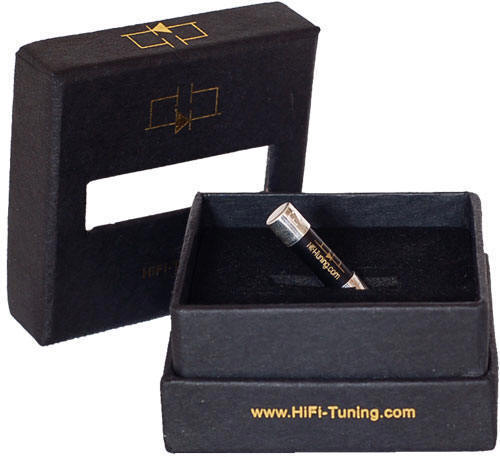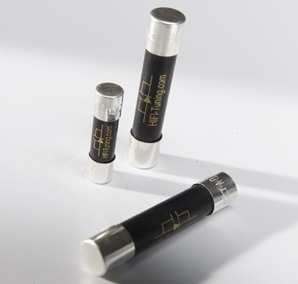HiFi Tuning Supreme fuses
|
Random Noise 31
HiFi Tuning Supreme fuses Fuses? Really?
|
|
Well, yes… Thanks to Uncle Clement’s urgings and suggestions, much to my delight, mine has become a tweak-infused system. (So let me thank the dear man here.) Briefly, then: four Acoustic Revive room-treatment panels; on their stands, four Stein Music H2 Harmonizers; Stein Music Magic Stones, Magic Diamonds, and Magic Blue Diamonds; two Acoustic Revive RR-77 Schumann Resonance generators; an Acoustic Revive disc demagnetizer; two BlackNoise line conditioners; Nordost Quasar Points under the amps; Aurum Acoustics points under that company’s Integris CDP; an Acoustic Revive quartz-crystal board under the Integris. It’s been my experience that every tweak makes a difference. The question is, how great a difference? How profound the effect? Is it always for the better? Not everything I’ve had here for comment is part of the present mix. Those items I most value are. I hear their contributions as persisting for the good. Which brings us to these fuses. In his heart of hearts, Uncle Clement sees me as a skeptic. No number of enthusiastic reviews can dislodge him from this prejudice. Therefore I see it as my mission to cover the tweak here examined in a fashion Unc’s bound to approve. It was he, after all, who described these HiFi-Tuning fuses to me in the warmest of terms. What seemed a good plan soon enough soured. I’ll explain. I thought it prudent to have a look at Moreno Mitchell’s May, 2011 HiFi-Tuning Supreme fuse report. The more I read the more furious I became. J’accuse, Moreno! You’ve perpetrated an act of pre-emptive plagiarism! Or something! Your observations so exactly track my own that no other interpretation is possible. Plagiarism! Or something! And time-travel too!
What strikes me as especially irksome is Moreno’s observations regarding directionality. He heard what I heard: with fuses first installed, both of us detected an uptick in clarity, which translates in audiospeak to better everything: transients, soundstage, musical timbres…. And, as did I, after some time, Moreno was made a wee bit uncomfortable by a less than endearing top-end. In my case, I confirmed a lingering sense of discomfort with what has become a test CD, a Haydn string quartet on the Tacet label. Producer Andreas Spreer records the Auryn Quartet with old Neumann mics. They’re justly famous devices with, in Spreer’s hands, especially brilliant highs I’ve come to rely on in detecting rough edges. The Auryn’s violins were a tad edgy. If a trace of skepticism remains – with me, as well as you, gentle reader – whence this twofold perception of not-quite-right? When I reversed the fuses, etched became silken. Flawed became flawless. (Well, close enough to….) I delight in arising an hour or so before first light and playing something at a volume that won’t disturb Lee. (It’s a big, two story house. Our bedroom’s upstairs, and there are doors to close.) Morton Feldman’s near-to-silent, long-distance scores for various combinations of traditional instruments have provided moments of epiphanic joy. I’m a Feldman fanatic. String Quartet 2, as recorded by members of the Ives Ensemble (hat[now]ART 4144, four CDs), runs for four hours, 45 minutes. I’m usually good for one disc per sitting. With this and other recordings, one’s perceptions of luminosity, space and detail, to which, unquestionably, HiFi-Tuning Supreme fuses contribute, make calling this a hobby seem almost insulting. HiFi-Tuning Supreme specifics include mention of ceramic bodies, painstaking metallurgy, gold-impregnated silver and – enter the MEGO effect – Quantum Mechanics. Quantum implementations have become quite the fashion in Audiophilia. Given what one hears, one can only suggest that there’s got to be something going on that resists explanation in conventional terms. Quantum schmantum, I like what these tiny items do. Moreover, HiFi-Tuning’s top-of-the-line fuses are a screaming bargain. But remember, you need to test for directionality. It’s important. *** A union of imponderables When electrified trolley cars were new to the world, a passenger asked how they worked. The conductor answered thus: that pole at the top there attaches to the overhead wire, I turn this handle, it goes. This approximates my understanding of two especially effective tweaks (predecessors of the fuses). I have it on the best authority, i.e., the horse’s mouth, that Holger Stein’s H2 Harmonizers, Magic Stones, Magic Diamonds and Magic Blue Diamonds operate via aspects of quantum mechanics. Another tweak I revere, Ken Ishiguro’s RR-77, is said to effect a domestic recreation of an outdoor global beneficence called the Schumann Resonance. You can Google Schumann Resonance for an understanding of what it is. But how this aspect of earth’s magnetic field ameliorates one’s RFI-infested listening room is, for me at least, a tad less fathomable. But I cherish what I hear. From what I understand of quantum mechanics (a shade less than nothing), objects in no way connected or obviously related can exercise an influence one to the other. Be that as it may, I’m impressed beyond measure by Holger Stein’s contributions to sweet-spot contentment. As to measure, I’m guessing that few to no members of the measurements-tell-the-story school would regard my impressions as other than imagined. Go in peace. I’m here to report to those who trust their ears that two properly elevated RR-77s operate in gorgeous harmony with four H2 Harmonizers. The mentioned tweaks – fuses, Harmonizers, RR-77s – contribute vibrant life to what, in their absence, would still be judged pretty good sound. *** Prima la musica…! At $100, The Decca Sound, consisting of 50 CDs and a 198-page booklet handsomely boxed, is too great an experience – and bargain! – to ignore. The music ranges from ancient to modern Western classical, with the bulk of it occupying the 19thand 20th centuries. The earliest music, a collection of dances, dates from 1551. Berlin cabaret songs, a Vienna New Year’s concert and the Three Tenors fall to the collection’s lighter side. The modernists include Edgard Varèse, a personal favorite. The Romantic school in all its aspects is well represented. The booklet relates the Decca Sound’s history, including a detailed discussion of the “microphone tree,” with equally informative production and track information. The collection’s far too various to summarize here. The reasonably well informed music buff will recognize most everything. More important, perhaps: for the less well informed yet curious listener, I can think of no better corrective than plunging fully clothed into this sea of wealth. Decca (which went in the US as London for a number of years) is one of the great labels. The recordings span the entirety of the stereo era. While better performances exist here and there, nothing in this collection is shabby. For example, the first disc features ravishing 1961 and ’62 performances of Debussy’s Images for Orchestra and Manuel de Falla’s The Three-Cornered Hat, with Ernest Ansermet conducting l’Orchestre de la Suisse Romande – a great ensemble in its day and a great conductor. As for those recording dates, my earliest experience of memorable sound emerged fromLPs bearing Decca’s FFSS and FFRR acronyms (Full-Frequency Stereophonic Sound and Full-Frequency Range Recording.) I mentioned the first disc. The last, number 50, consists in the main of a 1995 recording of William Walton’s Belshazzar’s Feast, about which, as typical of the comments praising these original releases, this excerpt of a Gramophone review: “The problems for the engineers must have been daunting, for the reverberation time is formidably long, yet thanks to brilliant balancing there is ample detail and fine focus in exceptionally incisive choral and orchestral sound. The great benefit is that this emerges as a performance on a bigger scale than its rivals, with the contrasts between full chorus and semi-chorus the more sharply established. The vividly dramatic soloist is Byrn Terfel, pointing the words as no one else ever has done in my experience.” A bargain at twice the price.
www.HiFiTuning.com
|
| Don’t forget to bookmark us! (CTRL-SHFT-D)
|
Stereo Times Masthead
Publisher/Founder
Clement Perry
Editor
Dave Thomas
Senior Editors
Frank Alles, Mike Girardi, Russell Lichter, Terry London, Moreno Mitchell, Paul Szabady, Bill Wells, Mike Wright, and Stephen Yan,
Current Contributors
David Abramson, Tim Barrall, Dave Allison, Ron Cook, Lewis Dardick, John Hoffman, Dan Secula, Don Shaulis, Greg Simmons, Eric Teh, Greg Voth, Richard Willie, Ed Van Winkle, Rob Dockery, Richard Doran, and Daveed Turek
Site Management Clement Perry
Ad Designer: Martin Perry








Be the first to comment on: HiFi Tuning Supreme fuses